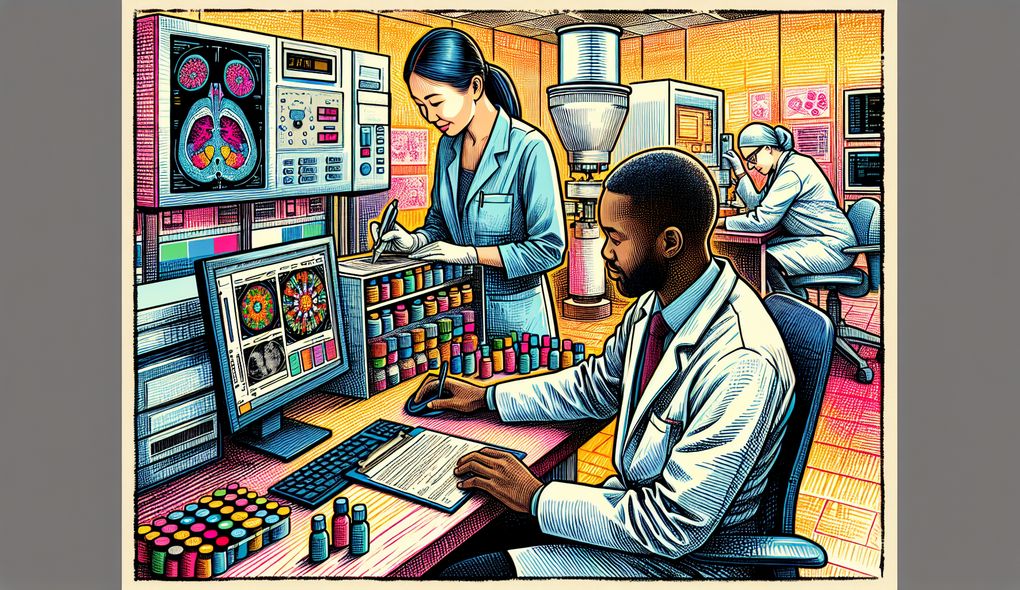How do you interpret nuclear medicine images accurately?
JUNIOR LEVEL

Sample answer to the question:
Interpreting nuclear medicine images accurately requires a thorough understanding of nuclear medicine practices and protocols. It involves analyzing various types of images, such as positron emission tomography (PET) scans and single-photon emission computed tomography (SPECT) scans. Additionally, it is essential to have strong analytical and problem-solving skills to interpret these images correctly. Communicating effectively with patients is also crucial when explaining procedures, risks, and results. Proficiency with nuclear medicine equipment and software is necessary to navigate and interpret the images accurately.
Here is a more solid answer:
To interpret nuclear medicine images accurately, it is crucial to have a comprehensive understanding of nuclear medicine practices and protocols. This involves analyzing various types of images, such as positron emission tomography (PET) scans and single-photon emission computed tomography (SPECT) scans, to identify abnormalities or patterns indicative of specific conditions. Strong analytic and problem-solving skills are essential to interpret these images correctly and make accurate diagnoses. Excellent communication and interpersonal abilities are also crucial when interacting with patients. This includes explaining procedures, risks, and results in a clear and compassionate manner. Additionally, proficiency with nuclear medicine equipment and software is necessary to navigate and interpret the images accurately. Having experience with different types of imaging software and staying up-to-date with advancements in technology can further enhance the accuracy of interpretation.
Why is this a more solid answer?
The solid answer provides more specific details on the skills and knowledge required to interpret nuclear medicine images accurately. It highlights the importance of understanding nuclear medicine practices and protocols, as well as the need for strong analytic and problem-solving skills. It also emphasizes the significance of excellent communication and interpersonal abilities when interacting with patients. However, it could still be improved by providing examples from the candidate's past experience or specific techniques used in interpreting nuclear medicine images.
An example of a exceptional answer:
Interpreting nuclear medicine images accurately requires a combination of technical expertise, clinical knowledge, and attention to detail. As a nuclear medicine physician, I have honed my skills in analyzing various types of images, including PET scans and SPECT scans, to detect abnormalities or patterns indicative of specific conditions. To ensure accuracy, I rely on my extensive knowledge of nuclear medicine practices and protocols, staying up-to-date with the latest advancements in the field. In addition to strong analytic and problem-solving skills, I excel in communicating effectively with patients, explaining complex procedures and providing compassionate care. My proficiency with state-of-the-art nuclear medicine equipment and software allows me to navigate and interpret images precisely. For example, I utilize advanced image reconstruction techniques and quantitative analysis methods to enhance diagnostic accuracy. By maintaining detailed records and collaborating with multidisciplinary teams, including radiologists, oncologists, and medical physicists, I ensure comprehensive patient care. Continuous participation in continuing education programs further allows me to refine my skills and stay at the forefront of nuclear medicine. Overall, my dedication to accuracy, comprehensive knowledge, and technical proficiency enable me to interpret nuclear medicine images with precision and provide optimal patient outcomes.
Why is this an exceptional answer?
The exceptional answer provides specific details and examples from the candidate's past experience as a nuclear medicine physician. It showcases a comprehensive understanding of nuclear medicine practices and protocols, as well as advanced techniques used in interpreting nuclear medicine images. It also highlights the candidate's expertise in communication, record-keeping, and collaboration with multidisciplinary teams. Additionally, it mentions the candidate's commitment to continuous learning and staying at the forefront of nuclear medicine. This answer demonstrates the candidate's exceptional qualifications and dedication to accuracy in interpreting nuclear medicine images.
How to prepare for this question:
- Review and familiarize yourself with various nuclear medicine imaging techniques, such as PET scans and SPECT scans.
- Gain hands-on experience with different types of nuclear medicine equipment and software.
- Stay updated with the latest advancements in nuclear medicine practices, protocols, and technology.
- Practice interpreting and analyzing nuclear medicine images to enhance your skills.
- Develop excellent communication and interpersonal abilities to effectively explain procedures, risks, and results to patients.
- Seek opportunities for collaboration with multidisciplinary teams to understand the role of nuclear medicine in comprehensive patient care.
- Participate in continuing education programs and conferences to stay informed about new developments in the field of nuclear medicine.
What are interviewers evaluating with this question?
- Strong analytic and problem-solving skills
- Knowledge of nuclear medicine practices and protocols
- Excellent communication and interpersonal abilities
- Proficiency with nuclear medicine equipment and software

